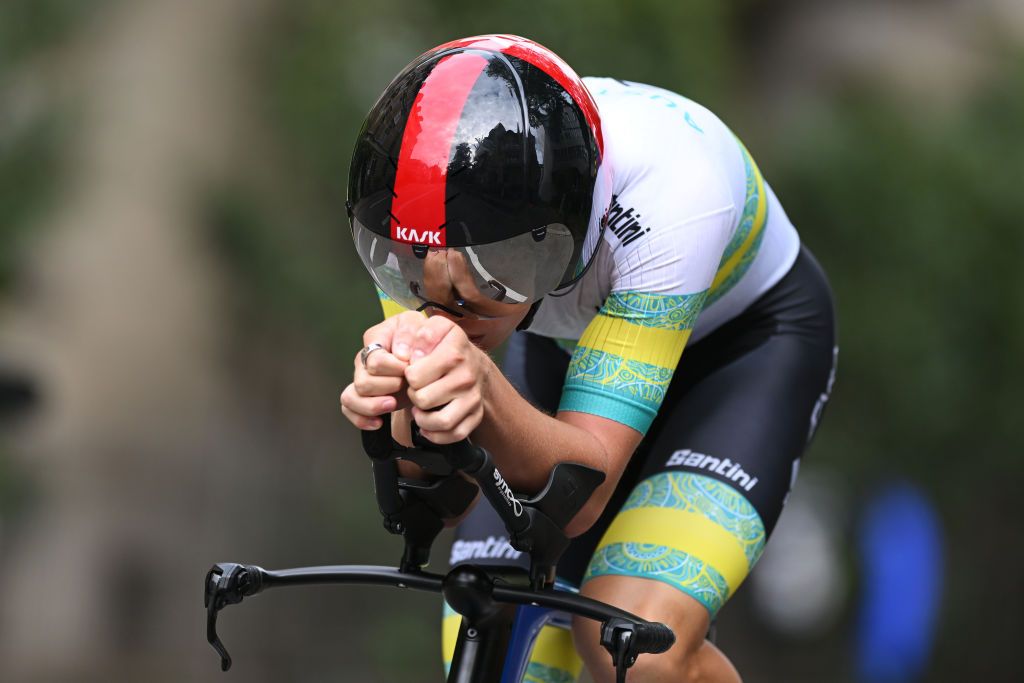World
Ohtani’s speed could be a World Series X-factor … if he runs

Shohei Ohtani‘s speed isn’t exactly a secret weapon. But home runs are king, even in a historic 50-50 season, and there’s no question Ohtani’s light-tower power is what commands the spotlight.
Just ask Aaron Judge, who, in the middle of lauding Ohtani as “the best player in the game” ahead of their World Series showdown, also said: “Doing what he did this year with the 50 stolen bases, it got talked about a lot, but I don’t think it got talked about enough.”
So let’s talk about it now. Because Ohtani’s speed could be the X-factor for the Dodgers in the World Series — even though it’s been somewhat hidden in the postseason so far.
Ohtani didn’t just have 59 steals in his first season with the Dodgers, nearly tripling his total of 20 from the year before, he had a historically successful stolen-base season. Ohtani stole his 59 bases while being caught only four times, a 94% success rate.
How did he do it? And is Ohtani’s stolen-base skill translatable to the World Series?
That’s an important question, because during the playoffs, Ohtani has run only once. And he was caught. So what if he doesn’t run against the Yankees? Or worse, what if he does run, and gets thrown out?
Well, the caught stealing against the Mets in the NLCS shouldn’t stop Ohtani from running in the World Series. Ohtani had successfully stolen 36 consecutive bases leading up to that. One caught stealing, which took a great throw by Francisco Alvarez (1.91 second pop time) and a perfect swipe tag by Francisco Lindor that barely grazed Ohtani’s jersey, can’t derail months of running rampant.
The bigger deal is Ohtani’s aggressiveness in stealing, which has seemingly vanished in the playoffs. An increase in aggressiveness is how Ohtani got to 50-50 with the Dodgers, not an increase in speed.
Ohtani is fast. But he’s always been fast. Ohtani’s average sprint speed this season, 28.1 ft/sec, was right in line with where it’s been ever since he came to the Major Leagues. That 28-29 ft/sec range, which is well above the MLB average of 27 ft/sec, is also Ohtani’s typical speed on stolen base attempts, and again, he stayed there in 2024.
Here’s how his base-stealing game has evolved:
1) He’s taking much bigger leads
This is the big thing that really stands out. Ohtani is getting the biggest leads of his career.
Specifically, his primary leads have increased dramatically — that’s how far he is off the base when the pitcher starts his delivery. Let’s look at Ohtani stealing second, since that’s what most steal attempts are, so it’s a more standard point of comparison. Ohtani’s primary leads in 2024 are a foot-and-a-half bigger than they were in 2023.
Ohtani’s avg. primary lead distance by season
SB attempts of 2B
This means that at the moment Ohtani takes off, he’s already shortened the distance between bases significantly. He has a full foot head start on an average MLB baserunner, and even more of a head start on himself from previous seasons of his career, when he was caught more often. On stolen base attempts, which are so often bang-bang plays, that extra foot-and-a-half Ohtani is taking from the pitcher and catcher matters a lot.
Ohtani has even gotten more and more aggressive as the season’s gone on. From Opening Day to the postseason, his leads have gotten bigger and bigger — as he stole second base successfully more and more.
Ohtani’s avg. primary lead distance by month in 2024
SB attempts of 2B
This year, Ohtani is also just putting himself in the best position to run more consistently than he used to. He isn’t only taking more aggressive leads when he actually steals, he’s taking more aggressive leads in all stolen base situations in general — in other words, any time he gets to first base with second base open ahead of him. That way, if Ohtani does get a read on the pitcher, he’s ready to go, and be safe.
Ohtani’s avg. primary lead from 1B by season
All potential SB situations (Ohtani on 1B with 2B open)
Since Ohtani has been able to maintain his speed from year to year while increasing his lead distance by a large margin in 2024, it’s easy to see how his stolen base success rate has gotten so high.
2) He’s more willing to steal third
This is another sign of Ohtani’s new aggressive base-stealing mindset. Ohtani used to never even risk stealing third. But this year, he’s taking that base.
Ohtani stole third base nine times this season, in 10 attempts (he was picked off second base once and thrown out at third on the play). He’d only stolen base 10 times total in his career before 2024. He went two seasons without even trying to steal third from 2019-20.
Ohtani’s steals of 3B (and attempts) by season
Ohtani tested the waters of stealing third in 2023. Now he’s jumped in. His attempts, and successful steals, of third base have gone from basically nonexistent early in his career, to meager, to nearly double what they were only a year ago.
A runner in scoring position for Mookie Betts or Freddie Freeman is tough enough on an opposing team. If that runner is Ohtani, the defense has to try to stop him from running now, too.
3) He’s seizing a lot more of his opportunities
Ohtani gets on base a lot. With his speed, that’s half the battle. Then he just has to run.
That’s the last (and obvious) part of the equation: When Ohtani has a stolen base opportunity, he is taking it a lot more often.
Baseball Reference tracks stolen base opportunities as the number of plate appearances where a baserunner has the next base open ahead of him. Ohtani always ends up with a lot of those opportunities, because he’s an elite hitter. He’s averaged 240 over the last four seasons, since his first MVP campaign in 2021.
But he hasn’t always turned those opportunities into actual steals at a high rate. Until now.
Ohtani’s SB attempts/opportunity by season
Ohtani has had some more chances to run compared to seasons past, that’s true. But only a few more opportunities than the last few years. The big change is the frequency that he’s taking off — more than twice as often as last year, and far more often than even his previous career-best year for steals in 2021, when he had 26 stolen bases.
What Ohtani has done with the Dodgers in 2024 parallels what Freddie Freeman did last year, just on a much larger scale. Freeman, out of nowhere, joined the 20-20 club in 2023 and led the Dodgers with 23 steals — a stolen-base increase that was likewise driven by much more opportunistic baserunning. The difference is that Ohtani has upper-echelon speed, and Freeman … does not. So the Dodgers stolen-base bump means “20-plus steals” for Freeman, but “50-plus steals” for Ohtani.
So … Why isn’t Ohtani running in the playoffs?
And yet, for all that running in the regular season, there’s only the one, solitary stolen base attempt in the postseason. Where has Ohtani’s aggressiveness gone?
Well, it’s not so much that Ohtani has stopped running, it’s that he’s been in fewer situations where he can run — and when he has gotten into base-stealing situations, they’ve been riskier ones.
The big story with Ohtani through the Dodgers’ first two playoff rounds was his hitting with the bases empty vs. his hitting with runners in scoring position. Namely, that was getting no hits with the bases empty, and all of his hits with runners on. That has an effect on stolen base opportunities, because if Ohtani’s hits are coming with runners on the bases in front of him, that reduces his chances to steal.
Even so, it’s not like Ohtani has had zero opportunities to steal. So what’s happening in those situations?
Ohtani has reached first base nine times this postseason with second base open in front of him. Five of those nine times have been with a left-handed pitcher on the mound. Ohtani does steal off lefties, but aggressive leads against left-handers run a higher risk of getting picked off. And this is the playoffs, where any out on the bases is magnified. With higher stakes, and the heart of the Dodgers order up, Ohtani might not want to push the envelope.
That leaves the four times Ohtani’s gotten on base against a righty with a chance to steal second. Two of those were against pitchers who are good at controlling the running game, Phil Maton and Ryne Stanek. The other two were against pitchers who are more average, Luis Severino and Reed Garrett — and Ohtani ran one out of those two times.
Which brings us to the Yankees. The Yankees’ relievers, overall, have been good at controlling the running game this year. But their top two starters, Gerrit Cole and Carlos Rodón, have not. So if Ohtani gets on base against them, especially the righty Cole, he could certainly look to steal.
And as for the Yankee catchers, Austin Wells has been fairly average at throwing runners out this year, while Jose Trevino has been one of the worse catchers in the league at containing the run game. So neither one, but particularly Trevino, should be any real deterrent to Ohtani running.
The Yankees will have to treat Ohtani as a threat to steal in the World Series. And with the 2024 Dodger version of Ohtani — with his excellent speed coupled with a newly aggressive base-stealing style — they might not be able to stop him anyway.




/cdn.vox-cdn.com/uploads/chorus_asset/file/24435784/tokyostrava.jpg)





